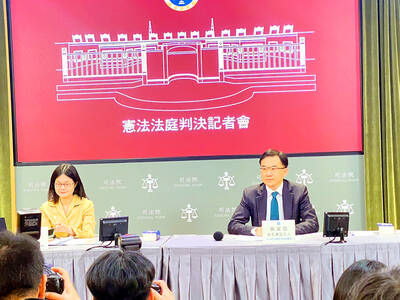President Chen Shui-bian (陳水扁) said yesterday that the so-called "1992 consensus" does not exist and that Chinese Nationalist Party (KMT) presidential candidate Ma Ying-jeou (馬英九) should stop pursuing his "Chinese dream" and drop the word "Chinese" from his party's name.
Chen made the remarks to reporters before a luncheon with Tainan community leaders.
The "1992 consensus" refers to an alleged agreement reached between Chinese and Taiwanese negotiators during talks in Hong Kong in 1992 to the effect that there is "one China, with each side having its own interpretation."
KMT Legislator Su Chi (蘇起) said in March last year he had made up the term "1992 consensus" before the transfer of power in 2000.
Chen said a "1992 consensus" does not exist, as Koo Chen-fu (辜政府) -- Taiwan's representative at the 1992 talks -- said so in a book.
Ma should stop pretending that the consensus exists, Chen said, before criticizing the KMT for canceling a plan to delete the consensus from an internal document over pressure from deep-blue supporters.
Chen called on Ma to "have balls and be brave," adding that otherwise he would not be able to resist Chinese military threats if elected president.
Chen also said that Ma lacks a political ideology of his own.
Ma opposed the lifting of martial law, the abolition of Article 100 of the Criminal Code and was in favor of indirect presidential elections at a time when activists were pushing for presidential elections by popular vote, Chen said.
Article 100 of the Criminal Code allowed people suspected of plotting to overthrow the KMT regime to be charged with sedition.
Chen said the "ultimate unification" supported by Ma is dangerous and that his bid to "return to the UN" using the name "Republic of China" is impossible.
"Ma is against democracy, against human rights, against reform and against Taiwan as a sovereign state and has always chosen to stand on the wrong side of history," Chen said.

TRAGEDY STRIKES TAIPEI: The suspect died after falling off a building after he threw smoke grenades into Taipei Main Station and went on a killing spree in Zhongshan A 27-year-old suspect allegedly threw smoke grenades in Taipei Main Station and then proceeded to Zhongshan MRT Station in a random killing spree that resulted in the death of the suspect and two other civilians, and seven injured, including one in critical condition, as of press time last night. The suspect, identified as a man surnamed Chang Wen (張文), allegedly began the attack at Taipei Main Station, the Taipei Fire Department said, adding that it received a report at 5:24pm that smoke grenades had been thrown in the station. One man in his 50s was rushed to hospital after a cardiac arrest

PUBLIC SAFETY: The premier said that security would be tightened in transport hubs, while President Lai commended the public for their bravery The government is to deploy more police, including rapid response units, in crowded public areas to ensure a swift response to any threats, President William Lai (賴清德) said yesterday after a knife attack killed three people and injured 11 in Taipei the previous day. Lai made the remarks following a briefing by the National Police Agency on the progress of the investigation, saying that the attack underscored the importance of cooperation in public security between the central and local governments. The attack unfolded in the early evening on Friday around Taipei Main Station’s M7 exit and later near the Taipei MRT’s Zhongshan

ON ALERT: Taiwan’s partners would issue warnings if China attempted to use Interpol to target Taiwanese, and the global body has mechanisms to prevent it, an official said China has stationed two to four people specializing in Taiwan affairs at its embassies in several democratic countries to monitor and harass Taiwanese, actions that the host nations would not tolerate, National Security Bureau (NSB) Director-General Tsai Ming-yen (蔡明彥) said yesterday. Tsai made the comments at a meeting of the legislature’s Foreign Affairs and National Defense Committee, which asked him and Minister of National Defense Wellington Koo (顧立雄) to report on potential conflicts in the Taiwan Strait and military preparedness. Democratic Progressive Party (DPP) Legislator Michelle Lin (林楚茵) expressed concern that Beijing has posted personnel from China’s Taiwan Affairs Office to its

‘ILLEGAL RULING’: The KMT and the TPP slammed the Constitutional Court judgement, saying it contravened the law and was trying to clear the way for a ‘green dictatorship’ The Constitutional Court yesterday ruled that amendments to the Constitutional Court Procedure Act (憲法訴訟法) passed by the Legislative Yuan last year are unconstitutional, as they contravene due legislative process and separation of powers. The Legislative Yuan on Dec. 20 last year passed amendments stipulating that no fewer than 10 grand justices must take part in deliberations of the Constitutional Court, and at least nine grand justices must agree to declare a law unconstitutional. The Executive Yuan on Jan. 2 requested that lawmakers reconsider the bill, but the Legislative Yuan, under a combined majority of Chinese Nationalist Party (KMT) and Taiwan People’s Party